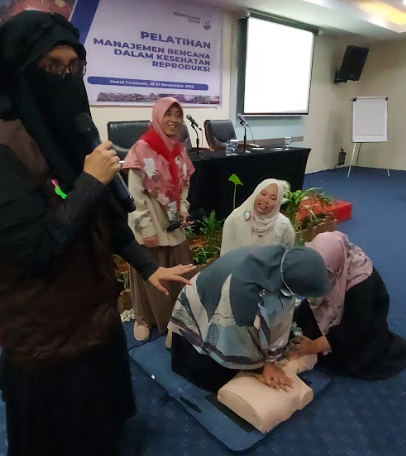Building a Culture of Disaster Preparedness in the Health Sector: Strengthening Community Capacity
Keywords:
Mitigation, Preparedness, Reproductive healthAbstract
The natural disaster of an earthquake with the potential to cause a tsunami is still a latent danger along the coast of West Sumatra. One of the efforts in disaster management is mitigation by building a culture of disaster preparedness in the health sector, starting with intensive training. The purpose of this training was to increase the capacity of the trainees. A total of 21 out of 25 participants fully participated in the activity. This service activity was carried out in several stages, starting from the planning and preparation stage, the implementation stage, and the evaluation stage. The training method is a participatory approach with an andragogy education model. We assessed capacity improvement objectively using pre and post-test assessment sheets. Most participants were 50-60 years old and had never participated in disaster training. Analysis using paired samples t-test showed a significant increase in participants' knowledge capacity (p<0.05), from an average of 69.4 to 91.2. An evaluation of partner satisfaction at the end of the activity completed the activities. Participants were satisfied with the material the resource persons presented and the tasks. The participants considered the duration of training sufficient. Participants expect to participate in further training for specific subjects.
References
Andresen, L., Boud, D., & Cohen, R. (2020). Experience-based learning. In Understanding Adult Education and Training. https://doi.org/10.4324/9781003118299-22
BNPB. (2014). Keputusan Kepala Badan Nasional Penanggulangan Bencana Nomor 173 Tahun 2014 tentang Klaster Nasional Penanggulangan Bencana (pp. 1–6). pp. 1–6. Jakarta: Badan Nasional Penanggulangan Bencana. Retrieved from https://bpbd.ntbprov.go.id/po-content/uploads/sk_bnpb_nomor_173_tahun_2014_tentang_klaster_nasional.pdf
Chasanah, U., Prastowo, T., Fisika, J., Universitas, F., & Surabaya, N. (2013). Analisis Tingkat Seismisitas Dan Periode Ulang Gempa Bumi Di Sumatera Barat Pada Periode 1961-2010. Jurnal Fisika, 2(2). Retrieved from https://core.ac.uk/download/pdf/230668158.pdf
Chernikova, O., Heitzmann, N., Stadler, M., Holzberger, D., Seidel, T., & Fischer, F. (2020). Simulation-Based Learning in Higher Education: A Meta-Analysis. Review of Educational Research, 90(4). https://doi.org/10.3102/0034654320933544
Cheung, S. Y., & Ng, K. Y. (2021). Application of the Educational Game to Enhance Student Learning. Frontiers in Education, 6. https://doi.org/10.3389/feduc.2021.623793
Coulson, D., & Harvey, M. (2013). Scaffolding student reflection for experience-based learning: A framework. Teaching in Higher Education, 18(4). https://doi.org/10.1080/13562517.2012.752726
de Sousa, L. O. (2021). Learning experiences of a participatory approach to educating for sustainable development in a South African higher education institution yielding social learning indicators. Sustainability (Switzerland), 13(6). https://doi.org/10.3390/su13063210
Domínguez, R. G. (2012). Participatory Learning BT - Encyclopedia of the Sciences of Learning (N. M. Seel, Ed.). Boston, MA: Springer US. https://doi.org/10.1007/978-1-4419-1428-6_1903
Ferdinan. (2020, November 13). Ahli Bicara Potensi Gempa M 8,9 Bila Terjadi Megathrust Mentawai. VOI. Retrieved from https://voi.id/berita/19675/ahli-bicara-potensi-gempa-m-8-9-bila-terjadi-megathrust-mentawai
Haleem, A., Javaid, M., Qadri, M. A., & Suman, R. (2022). Understanding the role of digital technologies in education: A review. Sustainable Operations and Computers, 3, 275–285. https://doi.org/10.1016/j.susoc.2022.05.004
Hanifa, L., Sadat, A., Mahmuda, D., Nazar, A., Jasiyah, R., Wijaya, R. S., … R A F, N. (2019). Handling disaster risks with the community-based approach. IOP Conference Series: Earth and Environmental Science, 235(1), 012034. https://doi.org/10.1088/1755-1315/235/1/012034
Munna, A. S., & Kalam, M. A. (2021). Impact of Active Learning Strategy on the Student Engagement. GNOSI: An Interdisciplinary Journal of Human Theory and Praxis, 4(2), 96–114. Retrieved from http://gnosijournal.com/index.php/gnosi/article/view/96
Negi, N. K., & Sohn, M. W. (2022). Sustainability After Project Completion: Evidence from the GEF. https://doi.org/10.1007/978-3-030-78853-7_4
OECD. (2009). Creating Effective Teaching and Learning Environments. OECD. https://doi.org/10.1787/9789264068780-en
Panza, G. F., Peresan, A., Sansò, F., Crespi, M., Mazzoni, A., & Nascetti, A. (2018). How geodesy can contribute to the understanding and prediction of earthquakes. Rendiconti Lincei, 29. https://doi.org/10.1007/s12210-017-0626-y
Park, J., & Park, D. H. (2019). A sustainable project management strategy against multitasking situations from the viewpoints of cognitive mechanism and motivational belief. Sustainability (Switzerland), 11(24). https://doi.org/10.3390/su11246912
Parsa, B., Murphy, S., Drynan, D., & Jarus, T. (2021). Reflection on professionalism: Retrospective review of health professional student reflections. International Journal of Practice-Based Learning in Health and Social Care, 9(1). https://doi.org/10.18552/IJPBLHSC.V9I1.669
Rozi, S., Ritonga, A. R., & Januar, J. (2021). ‘Local community-based disaster management’ The transformation of religious and local wisdom values in preparation to deal with natural hazards in West Sumatra, Indonesia. Jamba: Journal of Disaster Risk Studies, 13(1). https://doi.org/10.4102/JAMBA.V13I1.1020
Tasantab, J. C., Gajendran, T., Owi, T., & Raju, E. (2023). Simulation-based learning in tertiary-level disaster risk management education: a class-room experiment. International Journal of Disaster Resilience in the Built Environment, 14(1). https://doi.org/10.1108/IJDRBE-04-2021-0045
UN. (2015). Sendai Framework for Disaster Risk Reduction 2015 - 2030. In UNDRR. United Nation. Retrieved from http://www.undrr.org/publication/sendai-framework-disaster-risk-reduction-2015-2030

Published
How to Cite
Issue
Section
Copyright (c) 2023 Ulya Uti Fasrini, Tommy Susanto, Rezko Yunanda

This work is licensed under a Creative Commons Attribution-ShareAlike 4.0 International License.
Authors who publish with Poltekita: Jurnal Pengabdian Masyarakat agree to the following terms:
- Authors retain copyright and grant the journal right of first publication with the work simultaneously licensed under a Creative Commons Attribution License (CC BY-SA 4.0) that allows others to share the work with an acknowledgment of the work's authorship and initial publication in this journal.
- Authors are able to enter into separate, additional contractual arrangements for the non-exclusive distribution of the journal's published version of the work (e.g., post it to an institutional repository or publish it in a book), with an acknowledgment of its initial publication in this journal.
- Authors are permitted and encouraged to post their work online (e.g., in institutional repositories or on their website) prior to and during the submission process, as it can lead to productive exchanges, as well as earlier and greater citation of published work.

This work is licensed under a Creative Commons Attribution-Share Alike 4.0 International License
You are free to:
- Share, copy and redistribute the material in any medium or format
- Adapt, remix, transform, and build upon the material for any purpose, even commercially.
- The licensor cannot revoke these freedoms as long as you follow the license terms.

1.png)


